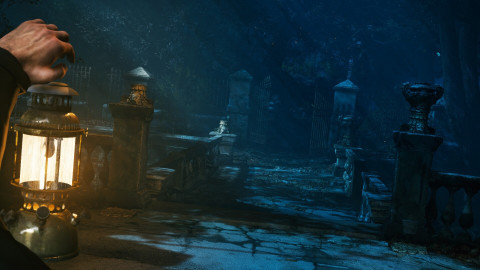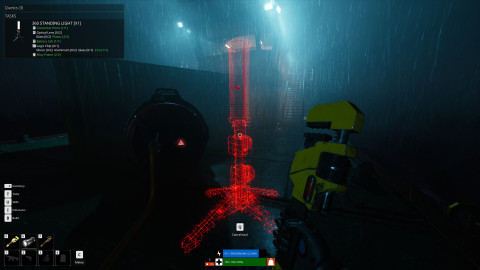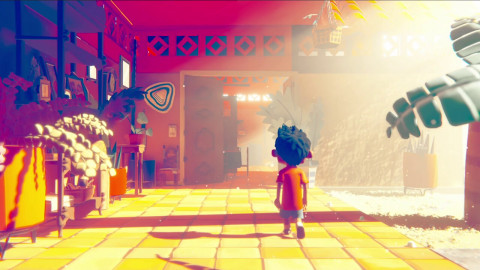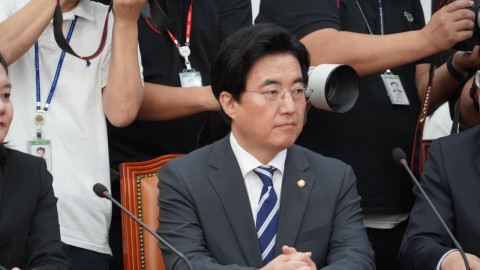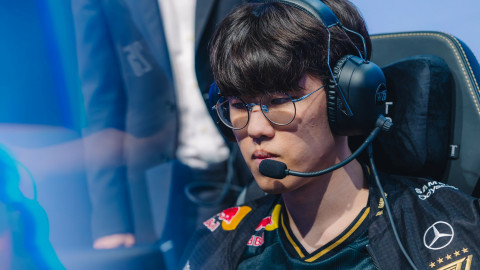
ASTRA: Knights of Veda, developed by Flint and published by HYBE IM, held a media showcase and interview on Mar. 25. FLINT CEO Kim Young-mo attended the event to explain ASTRA: Knights of Veda and answer questions from the media.
ASTRA: Knights of Veda is the first game published by HYBE IM, featuring story-based gameplay, distinctive artwork, and action-focused combat. It has met global users through events like G-STAR and Gamescom, and underwent extensive improvement based on user feedback from last year's global beta testing.
The game supports various play contents, allowing players to experience everything from story progression to character growth, boss battles, PvP, and season-based dungeons. The central content is the Adventure Mode, consisting of scenario dungeons where the story unfolds. Seven scenarios, each comprising 12 stages, are prepared, totaling about 20 hours of gameplay.
The demonstration took place on the PC platform, featuring an improved version after the last FGBT with auto-battle included. In ASTRA: Knights of Veda, auto-battle tracks and attacks target subjects, automatically performs skill usage, item acquisition, and dungeon progression.
Even with auto-battle enabled, manual control is possible. Players can manually move, dash, evade, and use powerful attacks and skills to engage in combat. Auto-battle pauses momentarily during manual operation and resumes when manual operation stops.
Upon playing the game, it was evident that auto-battle operates at a basic level, primarily moving towards enemies, using basic attacks and skills when a viable target is present, and looting items. Core elements like evading or changing characters are not automated.

As a result, manual combat felt much more efficient, especially in boss battles where enemy attacks come in short cycles. Particularly for some skills, if they are used, characters may stand still for an extended period, and they could overlap with enemy attacks. In this case, skills could be wasted, and some attacks became unavoidable.
Certainly, in the case of the PC platform, where all controls are convenient, manual combat was much more efficient than auto-battle. Additionally, due to the action-packed nature of combat, there was little perceived need for auto-battle. In fact, as enemies grew stronger towards the latter stages of the game, manual combat felt even more necessary.
Conversely, in cases where precise control is difficult, such as on mobile platforms, or when repeatedly farming specific maps, auto-battle appears to be quite useful. The development team explained that since targeting, movement, and attacks are automated, the fatigue from combat is significantly reduced.
Furthermore, many aspects have clearly improved compared to the previous test. The frustration of limited visibility has been greatly reduced, and the pace of combat has increased. As a result, overall immersion in combat has also improved. In particular, experiencing late-game play with a variety of characters, their characteristics, and skills felt significantly stronger.

CEO Kim Young-mo mentioned that they have been steadily working to increase satisfaction with ASTRA: Knights of Veda and that he determined to launch the game after achieving a score of 9.1 at the last G-STAR 2023. The highest score received was for graphics, scoring 9.6 out of 10.
CEO Kim Young-mo stated, "Developers exist because of users. If there are shortcomings, we will humbly accept them and continuously strive for improvement. We will diligently reflect on feedback to make the game loved for a long time."
ASTRA: Knights of Veda will be simultaneously released globally in over 130 countries on April 2 for mobile and PC (Steam, Windows).
The following is a full translation of the Q&A session with the media.

It seems that automatic combat is the biggest change. Why did you include it this time? Also, in the case of the Arena, won't advantages and disadvantages be determined by the differences in play environment on each platform?
The biggest challenge was whether automatic combat would be fun. We conducted numerous tests and discussions on this matter. We continuously thought about how to make it enjoyable even in the mobile environment. Through testing, we found that automatic combat significantly reduces fatigue in farming areas. There are attacks that must be avoided and hero replacements that must be done manually, which we believe can provide enough fun even during automatic combat. We extensively considered the aspect of enjoyment, and ultimately, we believe automatic combat adds a new dimension to the game.
As for the Arena, rewards are given based on rankings, and some rewards are given purely based on the points obtained, similar to a battle pass. Even if you lose, you still earn points. Since the Arena season lasts about three months, any user who plays diligently can obtain rewards. Even if you have a strong deck and perform well in the Arena, you're simply claiming rewards more quickly.
The automatic combat seems somewhat peripheral. Was this intentional? Also, I'm curious if the action-packed experience will be fully delivered on mobile.
It might vary depending on individual experiences, but I believe automatic combat is quite useful. Additionally, we confirmed that you can play through the entire game, including the last mission and the Arena, on mobile devices. However, we noticed a significant difference in fatigue depending on whether automatic combat was implemented on mobile. We provide various options, and by slightly lowering the specifications on mobile devices and enabling automatic combat, players can enjoy smooth battles in any situation. Therefore, I believe automatic combat is of great significance.
There seems to be some frustration with automatic combat. Are there any improvements planned?
I believe there should be a distinction between AI and automatic combat. AI completely replaces the actions of the player, while automatic combat only performs basic actions. We have defined the basic specifications of automatic combat to include only fundamental actions such as attacking targets, finding enemies, picking up items, and emergency evasions. As for emergency evasions, the character simply evades when their HP drops down to a certain percentage.
We received a lot of feedback through private influencer tests related to automatic combat. The feedback indicated that the current state is the most suitable. However, adding options if necessary is not a difficult task even though development is in the final stages.
Were there any synergies gained from preparing for the release with HYBE IM? Also, while both automatic and manual combat have their charms, there's a risk of missing out on both types of fans centered around each control method. What are your thoughts on this matter?
Launching a global cross-platform build is a significant challenge. Both parties are putting in tremendous effort because neither has perfect experience in this area. We are working hard to ensure smooth operation on multiple platforms at the time of release.
In the current era, games tend to specialize in specific platforms such as mobile or PC, but with a multi-platform approach, there's a risk of missing out on both sides. We are aware of the potential risk. However, I think it would be arrogant for us to judge the market first. Market judgment seems presumptuous. It seems more important to assess how much fun developers had internally and how viable they think it is in the market. We received proactive feedback from HYBE IM as well. I believe both sides can have competitiveness.

The combat seems to be primarily focused on regular attacks, and skills appear to be short-lived, which can still be frustrating. Are the skills fixed in their current state? Also, Are there plans for what happens after collecting Veda's shards, which seems to be the main goal?
I consider the game to be primarily focused on skill-based combat rather than regular attacks. The core of ASTRA: Knights of Veda lies in its attributes. Continuously attacking enemies with specific attributes builds resistance, and attacking them with opposing attributes inflicts much higher damage. It's important to learn this process, and if you fail, it can feel frustrating. We've made a lot of efforts to address this issue. Also, the playtest ran for only about an hour today, if you play for a longer duration, things like artifact options and weapon upgrades become more significant. In such situations, the game becomes more skill-focused. I believe expanding the scope is quite feasible.
In terms of Veda's shards, you barely collect one in Season 1's story. There are still 11 remaining. We expect users to collect about two per year. We believe we have about six years' worth of story and setting material prepared. It's planned to unfold as per the setting.
The action pace and the control seem to have improved significantly. Were there any difficulties in making adjustments within a short period? Was there any memorable feedback?
We've received feedback from the global community. Most of the feedback was understandable, and we've fixed almost all of it. It provided us with insight into how high the standards of players have become and what we can learn. About 2,000 items were listed in the feedback list. We made adjustments and improvements to make it feel like feedback was heard. Global testing was extremely helpful. The period of fixing the areas where we received feedback was a profound and good time.
Where did you focus on to deliver the story and the world?
Since players can skip or fast-forward through the story, we put a lot of effort into the 'wow' moments and thought about where players could emotionally engage. As the story progresses, everything, including direction, action, and emotions, becomes stronger. We also put a lot of effort into making the ending a gift to the fans of ASTRA (Dragon Blaze).
Characters from Dragon Blaze, including Bell Snow, make appearances. Are these homages?
To be precise, ASTRA: Knights of Veda is a prequel. So, the characters that appear do indeed match with Dragon Blaze.

It seems like the power of Rampaging Star has changed. Also, the control of long-range characters seems to have improved. What feedback did you receive?
The power of Rampaging Star was originally triggered randomly. Many users were dissatisfied with it because it was randomly activated. We were worried about homogenized play if it wasn't random, but surprisingly, changing it made it more interesting. So, we changed it so that users can detonate it according to their choice.
As for long-range characters, there was talk that archers are weak in wide-area combat. Although there are slight differences depending on the character, regular attacks now penetrate. So now, even with just regular attacks, you can conduct wide-area combat to some extent. The attack speed has also increased.
How are the resistance system and other features implemented in multiplayer?
We've made many improvements to multiplayer as well. You can enjoy all the content in multiplayer from the beginning. Since breaking resistance is essential to the game, it's challenging to prepare for opposing attributes in the early stages. This aspect is covered when playing in a party.
What are the goals after the release? How will you apply feedback from the initial release?
The goal is to be remembered as a provider of a remarkable game. Of course, achieving notable outcomes is essential; this fosters a cyclical structure where we can reinvest in the game. Even for future updates, I hope for favorable outcomes. Since our game is a live service rather than a packaged one, it's not about releasing a finished product. We believe that user feedback is crucial for improvement even after the launch. The current version has undergone significant improvements based on feedback, so we are open to further enhancements. It was a deeply meaningful and enriching time to refine feedback.
You mentioned that you would focus heavily on communicating with users. What are your plans to do so after the release?
We plan to have small updates every three weeks and content updates every six weeks. We'll provide thorough explanations on our official website and conduct broadcasts where directors introduce the content every six weeks. Even for significant issues or improvements, we'll explain through director notes. Moreover, we plan to transparently disclose this year's schedule after the release.

Did you draw inspiration from Genshin Impact? Can you tell us about other references in the content?
Genshin Impact is indeed an excellent game, and we drew inspiration from it. Besides, we were influenced by various other content such as Blasphemous, Dark Souls, Bloodborne, and the Alien series. Genshin Impact set the standard for cross-platform mobile games, so we took many lessons and studied it extensively.
Are there any collaboration events in preparation, given that collaborations have become a significant aspect of recent games?
Of course, collaborations are in the works. We're preparing collaborations with popular animations and games, and some collaborations have already been finalized to some extent. When these collaborations are released, we aim to integrate them into the storyline of ASTRA: Knights of Veda as much as possible. We're considering adopting some of the latest works for collaboration.
With a global simultaneous release, do you have any specific target markets in mind? Also, character collection seems to be a core aspect of the game. How often do you plan to release new characters?
While it may be ambitious, our goal is to be loved by players from all markets equally, rather than focusing on specific countries. As for characters, we have quite a few already completed, and we plan to release them every three weeks. Each character has been meticulously crafted, with the intention for players to learn about and develop affection for each one individually. We want players to enjoy every character's story, PV video, and background, consuming them with the same enthusiasm. Therefore, we intentionally limited the number of initial characters.
Characters and equipment seem to be mixed in gacha. Could you explain the composition?
Currently, characters and equipment can be obtained together. Since both characters and equipment play equally important roles, we have structured the gacha system in this way.
In the demo version, it wasn't possible to check the BM aspects. Can you tell us about the BM at the time of release?
The BM was a topic of much consideration for us. We paid attention to many details and believe that user satisfaction with BM is crucial. Therefore, we made extensive preparations in this regard. Transparency in BM is essential, and we have ensured it by meticulously detailing our policies. We have also structured the offerings to maximize user satisfaction. Additionally, we have prepared numerous release events. Even without making purchases, players can enjoy acquiring in-game currency significantly.

A new paid currency called Ruby has been added. Why did you divide the currency into Ruby and Star Stones? Also, weapons aren’t equipped automatically. Is there a reason for this?
Given that we are providing a global service, we divided currencies into paid and free to adapt to the payment laws of each country. We wanted to ensure that users can clearly distinguish between paid and free currencies. Star Stones and Ruby serve the same purpose. Except for the battle pass, all items can be purchased with either currency.
As for automatic equipment attachment, it is available for accessories and artifacts but not for weapons. Weapons are the only paid items, while the rest can be obtained in-game. Since players can acquire the items in-game while comparing them, we didn't support automatic attachment for weapons, assuming that players would pay sufficient attention to acquiring characters and equipment.
Recently, many global release games have significantly lowered specifications for optimization. What are the recommended specifications for ASTRA: Knights of Veda?
ASTRA: Knights of Veda is a 2D game, so the recommended specifications aren’t that high. It can be played on old devices with minimum specs. We put a lot of effort into optimization. The minimum specifications for Android are Galaxy S8, for iOS is iPhone 10s, and the recommended specifications are iPhone 11 or higher. For PC, it runs on a minimum of 8GB RAM and a graphics card of 750ti or higher. Having minimal differences in graphics between mobile and PC is advantageous.
When we think of HYBE, we think of idol celebrities. Do you plan to incorporate characters from idol groups?
We are currently discussing this with HYBE IM. We might gradually reveal this when the time comes.
With the release approaching soon, please share your final thoughts.
Personally, this project has been the culmination of many efforts. With high expectations and considerable tension, I remain committed to delivering a highly polished service without losing sight of our original intentions. Since it's a global simultaneous release, maintaining the service and delivering it well are our priorities. We have prepared extensively to showcase and provide an exceptional service. I promise to deliver on that.
Sort by:
Comments :0




